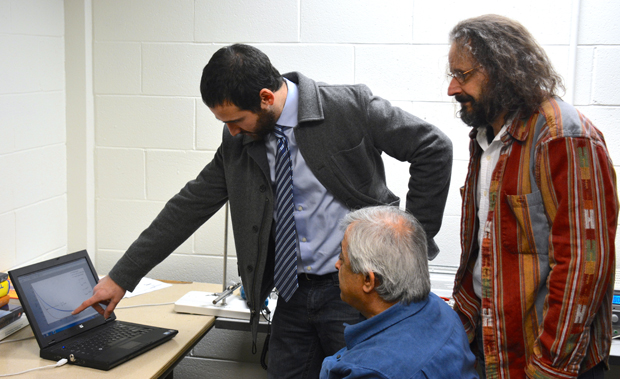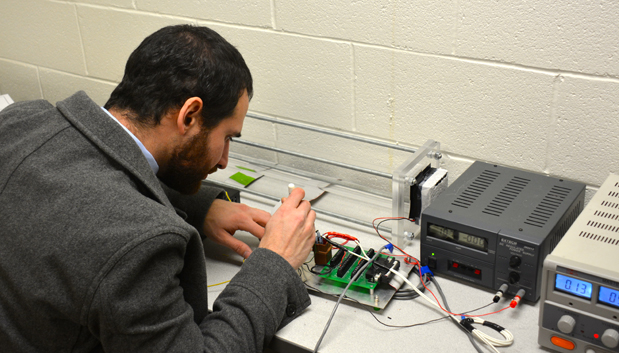Have you ever watched a space shuttle—on TV or in a movie—barreling toward the Earth and held your breath until the moment the shuttle safely entered the Earth’s atmosphere without catching on fire or exploding? Have you ever thought about why space shuttles normally don’t burst into flames during the hypersonic speeds and extremely hot temperatures? Leave it to engineers, like those in MABE, who are working on thermal protection of hypersonic flight vehicles and developing products to accurately measure high heating rate temperatures, to keep pilots and shuttle equipment safe.
About four years ago, NASA funded Dr. Jay Frankel and Dr. Majid Keyhani to work on thermal protection systems of flight vehicles subjected to severe aerodynamic heating. They had to figure out how to accurately measure high heating rate temperatures using thermocouples installed in their test samples. Thermocouples are used in many applications to measure temperature where rapid heating occurs. “It is well known that measured data is attenuated and delayed so you really do not know the actual temperature,” Dr. Keyhani said. “Attenuation and time delay can cause significant error.”
Alex Hashemian, MABE graduate student, began working on the research project more than three years ago, first as an undergraduate research assistant in 2011 and now, as a graduate student. The research team’s solution to the challenge of measuring temperature accurately is a custom thermocouple design, which is composed of two leads of different diameters that act to thermally balance the thermocouple, and a test procedure that is used to measure thermal response characteristics of the installed thermocouple. “Using the response characteristics of the installed thermocouple, we can then remove the attenuation and the time delay from the measured temperature data,” Dr. Keyhani said.
As of now, there are no restrictions on the medium of the installed thermocouple probe. “It just happens that for our research, the thermocouples were installed in a solid,” Dr. Keyhani said. “However, it can be installed in a fluid stream. The measured response time of an in-situ thermocouple probe in a fluid stream is really giving us the value of the convection heat transfer coefficient for the probe.” Dr. Keyhani noted that they know heat transfer coefficient correlates very well with velocity. “Alex has collected benchmark data that shows excellent correlation between the measured time constant and fluid velocity. I may add, though, that there are accuracy issues about measuring low velocities. So, our invention can be used as a dual-purpose probe, temperature and low velocity, when installed in a fluid stream,” Dr. Keyhani said.
Due to the research team’s successful data collection, in late November 2013, the UT Research Foundation filed for a provisional patent for intellectual property (IP) disclosed by Hashemian, and Drs. Keyhani and Frankel. The title of the disclosure is “Balanced-Leads Thermocouple Designed for In-Situ Response Characterization and Low Fluid Velocity Measurements.”
One might say that Hashemian is following in the footsteps of his father. He stated that his research is directly related to the work his father, Dr. H. M. Hashemian, has done for the nuclear energy industry at AMS Corp., a business Dr. Hashemian co-founded in 1977 with UT Nuclear Professor, Dr. T. W. Kerlin. “I’m very pleased with what my research has evolved into. It was a long campaign of work and experimentation that concludes with this patent. My research project has utilized much of my father’s knowledge of in-situ sensor characterization. I’m proud to have improved upon his work, and apply it toward the development of this invention,” Hashemian said.
Dr. Keyhani stated that the invention responds to a growing need in the science and engineering industries as a new means to measure transient temperatures more accurately, especially for rapid transients. “The product of this patent will be important in almost all applications involving transient temperature measurements such as materials research, process control, and a variety of aerospace and avionics applications,” he said. He noted that thermocouple manufacturers often report measured response times for their thermocouple probes by subjecting them to a step temperature change by sudden insertion in hot water or air flowing at certain velocity. “This response information is only useful when the customer intends to use the probe under the exact test conditions performed by the manufacturers. Therefore, we must measure the response characteristics of a thermocouple probe after installation,” Dr. Keyhani said. The knowledge of the thermal response time of the installed thermocouple is necessary to correct the measured data for the inherent time delay and attenuation of the measured signal, he said.
Hashemian stated it has been a pleasure working with Dr. Keyhani and Dr. Frankel. “I’ve learned to be a good analyst from Dr. Frankel’s careful analysis of data, and from Dr. Keyhani, my mentor, I’ve learned to be a careful experimentalist. He has taught me the importance of developing physical insight, a skill I intend to apply in my future work as an engineer,” Hashemian said. The biggest accomplishment for Dr. Keyhani was that he trained an undergraduate mechanical engineering student to become a M.S. degree-seeking student, a great researcher, and a co-inventor on a patent. Speaking on behalf of Dr. Frankel, Dr. Keyhani stated, “We are educators and researchers. On both fronts, we have succeeded with Alex.” MABE congratulates this hard-working team on an invention that brings the science and engineering world one step closer to accurately measuring transient temperatures.

